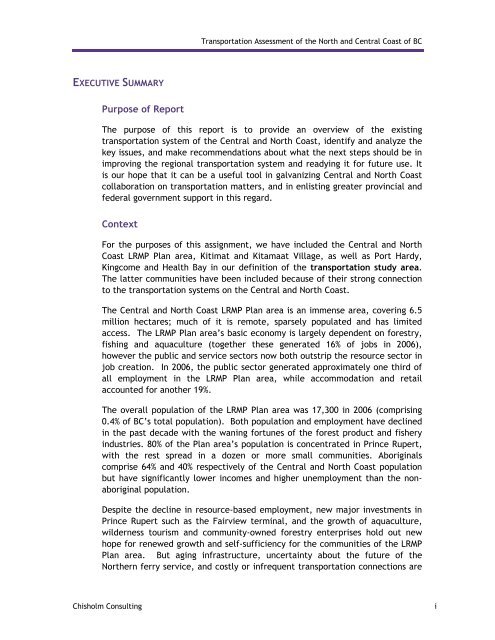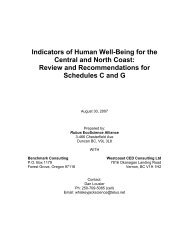Final report - Integrated Land Management Bureau
Final report - Integrated Land Management Bureau
Final report - Integrated Land Management Bureau
You also want an ePaper? Increase the reach of your titles
YUMPU automatically turns print PDFs into web optimized ePapers that Google loves.
EXECUTIVE SUMMARY<br />
Purpose of Report<br />
Transportation Assessment of the North and Central Coast of BC<br />
The purpose of this <strong>report</strong> is to provide an overview of the existing<br />
transportation system of the Central and North Coast, identify and analyze the<br />
key issues, and make recommendations about what the next steps should be in<br />
improving the regional transportation system and readying it for future use. It<br />
is our hope that it can be a useful tool in galvanizing Central and North Coast<br />
collaboration on transportation matters, and in enlisting greater provincial and<br />
federal government support in this regard.<br />
Context<br />
For the purposes of this assignment, we have included the Central and North<br />
Coast LRMP Plan area, Kitimat and Kitamaat Village, as well as Port Hardy,<br />
Kingcome and Health Bay in our definition of the transportation study area.<br />
The latter communities have been included because of their strong connection<br />
to the transportation systems on the Central and North Coast.<br />
The Central and North Coast LRMP Plan area is an immense area, covering 6.5<br />
million hectares; much of it is remote, sparsely populated and has limited<br />
access. The LRMP Plan area’s basic economy is largely dependent on forestry,<br />
fishing and aquaculture (together these generated 16% of jobs in 2006),<br />
however the public and service sectors now both outstrip the resource sector in<br />
job creation. In 2006, the public sector generated approximately one third of<br />
all employment in the LRMP Plan area, while accommodation and retail<br />
accounted for another 19%.<br />
The overall population of the LRMP Plan area was 17,300 in 2006 (comprising<br />
0.4% of BC’s total population). Both population and employment have declined<br />
in the past decade with the waning fortunes of the forest product and fishery<br />
industries. 80% of the Plan area’s population is concentrated in Prince Rupert,<br />
with the rest spread in a dozen or more small communities. Aboriginals<br />
comprise 64% and 40% respectively of the Central and North Coast population<br />
but have significantly lower incomes and higher unemployment than the nonaboriginal<br />
population.<br />
Despite the decline in resource-based employment, new major investments in<br />
Prince Rupert such as the Fairview terminal, and the growth of aquaculture,<br />
wilderness tourism and community-owned forestry enterprises hold out new<br />
hope for renewed growth and self-sufficiency for the communities of the LRMP<br />
Plan area. But aging infrastructure, uncertainty about the future of the<br />
Northern ferry service, and costly or infrequent transportation connections are<br />
Chisholm Consulting i

















